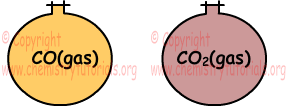Kinetic Theory of Gases
Kinetic Theory of Gases
Kinetic theory is a model that deals with motion of gas atoms/molecules in a closed container.
- Gas molecules or atoms do random motions in container.
- During this random motion, they collide to each other and surface of container.

- They diffuse homogeneously in the container. If we put two different gases into same container, they produce homogeneous mixture.
- Spaces between molecules and atoms in gases are larger than spaces between particles in solids and liquids.
- At an instant time speeds of gas atoms/molecules are not equal. They are inversely proportional to square root of molecular mass and directly proportional to square root of absolute temperature.
- At same temperature, average kinetic energies of all atoms/molecules are equal.
- Collisions of gas atoms/molecules to each other and surface of container are elastic, thus no energy is lost.
- Attraction between gas atoms/molecules are weak.
All properties given above are belong to ideal gas. However, there is no such a gas obeying these rules. Gas should have low pressure and molar mass and high volume and temperature to become ideal gas. If gases are compressed ( increasing pressure, decreasing temperature), they are condensed.
Example: Which one of the following statements related to gases is false.
I. They can produce homogeneous mixtures.
II. Density of same matter in gas phase is smaller than density of liquid phase.
III. They are fluid.
IV. They apply same pressure at every point of container.
V. They can be condensed under low pressure and high temperature.
All of the statements are true except from V. It must be;
Gases are condensed under high pressure and low temperature.
Example: Which ones of the following statements are true related to given gases under same conditions.

I. Pressures of the gases result from collisions of atoms/molecules to each other.
II. Both of the gases have equal average kinetic energy.
III. Number of molecules colliding unit surface in unit time in first container is larger than second container.
Solution:
Gas pressure results from collision of particles to the surface of container. Thus; I is false.
II and III are true.